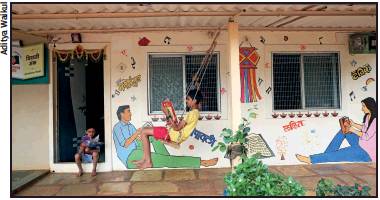Bhilar, village
This is a collection of articles archived for the excellence of their content. |
Libraries, for book-loving tourists/ 2019
Swatee Kher, June 1, 2019: The Times of India

From: Swatee Kher, June 1, 2019: The Times of India

From: Swatee Kher, June 1, 2019: The Times of India
With strawberries & libraries, ‘book village’ on tourist map
A cosy sofa and wicker chairs overlooking a beautiful valley, the quiet of a village, and lush strawberry fields all around — what more could a romantic soul wish for? It’s the setting for a great novel, perhaps even a great travel story. But this isn’t fiction; this is the living room of Bhiku Bhilare of Bhilar village, Maharashtra. But it offers much more than a pictureperfect setting — it also doubles up as a library.
Until recently, the village, just a few kilometres from the picturesque hill stations of Mahabaleshwar and Panchgani, was known for growing the best strawberries in the country. Now, it is a unique ‘village of books’ with 25 villagers having given up a part of their homes to set up open libraries.
The idea was inspired by the Welsh village of Hay-on-Wye, which is informally known as the ‘town of books’, and has scores of second-hand and antiquarian bookstores. But the Maharashtra government has made the concept their own and expanded its scope. Its Marathi language department’s experts meticulously put together a collection of over 30,000 books organised under various genres.
Each home is allotted books of one genre
These were then distributed among the home libraries, as well as public places like temples and schools. Each home is allotted books pertaining to one genre and identified with street signs and wall paintings.
Clearly, this is a reader’s paradise, apart from being a tourist’s. And for those lucky few whose interests converge, what could be better? Just drop by a house, pick up a book and read it to your heart’s content. The villagers, meanwhile, welcome the outsiders. At Ganpat Parthe’s house, for instance, women were sorting rice, wheat and jowar in the verandah when a family of visitors walked in. “We carry on with our work even when the visitors come. One family member shows them the books kept in the cupboards in the hall and then they can sit on the sofas or the balcony and read for as long as they want. They are not a hindrance to us,” Parthe said.
Almost all the 2,000-plus villagers share this enthusiasm. Ganpat Bhilare, a police patil (helper), said most villagers who joined the project are engaged in strawberry cultivation. “We thought it will be good for our children. They get to meet prominent thinkers, writers and attend workshops. It will help build an interest in literature,” said Ganpat, whose house has a collection of special Diwali magazines, which are a unique, century-old tradition in Maharashtra.
The success of the project, launched in May 2017, can be gauged by the number of visitors which has gone up from a few hundred during strawberry season to several thousand throughout the year. Bhushan Gagrani, principal secretary, Marathi language department, credited the villagers for its success. “There is no subsidy or incentive that they are getting. The government is just creating the social infrastructure — new roads, amphitheatre, parking space, dormitories,” he said.
So, why was Bhilar chosen for this project? Its location on a tourist trail meant it would have a captive readership, said Gagrani. “We started with 15,000 books, but the collection has grown. Many have donated from their personal collections,” he added.
One such person is Bhiku, who has added his own small collection to the library. Today, the retired 84-year-old school teacher’s living room has two huge cupboards lined with books on social reform and the history of revolutions. “During my school days, we had to travel to nearby towns to find books. Having a library open to everyone in my own home was a very different and exciting thought. We look at this concept as social work — our contribution to promoting reading,” Bhiku said.
A few metres away, Shilpa Sawant has converted a guest room in her single-storey home into a library of comics and humour books, with a collection of 850. A homemaker and avid reader herself, Sawant feels that she is doing her bit for society.
The village is also unique in the absence of fear of outsiders among the people. Mangal Bhilare’s quaint home looks as if it is straight out of a painting. The fully-grown mogra, jasmine and bougainvillea hanging from the roof and vividly painted walls draw visitors towards her home, the verandah of which contains a collection of fiction books.
“Unlike in cities, our homes are never locked. We always have someone dropping by. We are not afraid of strangers entering our homes. They just come, read a book for a few hours and go,” Mangal said.